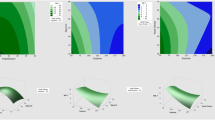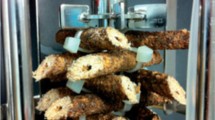Abstract
Bacillus subtilis natto is the key microorganism for the industrial production of menaquinone-7. The fermentation of this bacterium in static culture is associated with biofilm formation. The objective of this study was to determine the effect of biofilm formation on menaquinone-7 production to develop a suitable bio-reactor for the production of menaquinone-7. In the static culture, menaquinone-7 biosynthesis showed a linear correlation with biofilm formation (R 2 = 0.67) and cell density (R 2 = 0.7). The amount of biofilm, cell density and menaquinone-7 formation were a function of nutrient and processing conditions. Glycerol, soy peptone, and yeast extract mixture and 40 °C were found to be the optimum nutrients and temperature for accelerating both biofilm and menaquinone-7 biosynthesis in static culture. However, glucose, mixture of soy peptone and yeast extract and 45 °C were found to be the optima for cell density. As compared to the static culture, the biofilm formation was significantly inhibited when a shaken fermentation was used. However, shaking caused only a small decrease on menaquinone-7 production. These results demonstrate that the biofilm formation is not essential for menaquinone-7 biosynthesis. This study underlines the feasibility of using large scale stirred fermentation process for menaquinone-7 production.







Similar content being viewed by others
References
O’Toole, G. A., Kaplan, H. B., & Kolter, R. (2000). Biofilm formation as microbial development. Annual Review of Microbiology, 54, 49–79.
Parsek, M. R., & Greenberg, E. P. (2005). Sociomicrobiology: The connections between quorum sensing and biofilms. Trends in Microbiology, 13, 27–33.
Branda, S. S., Vik, Å., Friedman, L., & Kolter, R. (2005). Biofilms: The matrix revisited. Trends in Microbiology, 13, 20–26.
Kuchma, S. L., & O’Toole, G. A. (2000). Surface-induced and biofilm-induced changes in gene expression. Current Opinion in Biotechnology, 11, 429–433.
Khiyami, M. A., Pometto, A. L, I. I. I., & Kennedy, W. J. (2006). Ligninolytic enzyme production by Phanerochaete chrysosporium in plastic composite support biofilm stirred tank bioreactors. Journal of Agriculture and Food Chemistry, 54, 1693–1698.
Villena, G. K., & Gutierrez-Correa, M. (2006). Production of cellulase by Aspergillus niger biofilms developed on polyester cloth. Letters in Applied Microbiology, 43, 262–268.
Cheng, K. C., Demirci, A., & Catchmark, J. M. (2010). Effects of plastic composite support and pH profiles on pullulan production in a biofilm reactor. Applied Microbiology and Biotechnology, 86, 853–861.
Rahman, M. S., Ano, T., & Shoda, M. (2007). Biofilm fermentation of iturin A by a recombinant strain of Bacillus subtilis 168. Journal of Biotechnology, 127, 503–507.
Dam, H. (1935). The antihemmorhagic vitamin of the chick: Occurrence and chemical nature. Nature, 135, 652–653.
Meurer, J., Meierhoff, K., & Westhoff, P. (1996). Isolation of high-chlorophyll-fluorescence mutants of Arabidopsis thaliana and their characterisation by spectroscopy, immunoblotting and Northern hybridisation. Planta, 198, 385–396.
Collins, M. D., & Jones, D. (1981). Distribution of isoprenoid quinone structural types in bacteria and their taxonomic implications. Microbiology and Molecular Biology Reviews, 45, 316–354.
Tsukamoto, Y., Kasai, M., & Kakuda, H. (2001). Construction of a Bacillus subtilis (natto) with high productivity of vitamin K2 (menaquinone-7) by analog resistance. Bioscience, Biotechnology, and Biochemistry, 65, 2007–2015.
Berenjian, A., Mahanama, R., Talbot, A., Biffin, R., Regtop, H., Valtchev, P., et al. (2011). Efficient media for high menaquinone-7 production: Response surface methodology approach. New Biotech, 28, 665–672.
Mahanama, R., Berenjian, A., Valtchev, P., Talbot, A., Biffin, R., Regtop, H., et al. (2011). Enhanced production of menaquinone 7 via solid substrate fermentation from Bacillus subtilis. International Journal of Food Engineering, 7, art. no. 17.
Eddy, D. M., Johnston, C. C, Jr, Cummings, S. R., Dawson-Hughes, B., Lindsay, R., Melton, L. J, I. I. I., et al. (1998). Osteoporosis: Review of the evidence for prevention, diagnosis, and treatment and cost-effectiveness analysis, Status report. Osteoporosis International, 8, S1–S82.
Gast, G. C. M., De Roos, N. M., Sluijs, I., Bots, M. L., Beulens, J. W. J., Geleijnse, J. M., et al. (2009). A high menaquinone intake reduces the incidence of coronary heart disease. Nutrition Metabolism Cardiovascular Diseases, 19, 504–510.
Morikawa, M., Kagihiro, S., Haruki, M., Takano, K., Branda, S., Kolter, R., et al. (2006). Biofilm formation by a Bacillus subtilis strain that produces γ-polyglutamate. Microbiology, 152, 2801–2807.
O’Toole, G. A., Pratt, L. A., Watnick, P. I., Newman, D. K., Weaver, V. B., & Kolter, R. (1999). Genetic approaches to study of biofilms. Methods in Enzymology, 310, 91–109.
Park, R. S., Mayne, C. S., & Keady, T. W. J. (2002). Silage production and utilization. Wageningen: Wageningen Academic Publishers.
Betancur, G. J. V., & Pereira, N, Jr. (2010). Sugar cane bagasse as feedstock for second generation ethanol production. Part II. Hemicellulose hydrolysate fermentability. Electronic Journal of Biotechnology, 13, 14–15.
Sato, T., Yamadaa, Y., Ohtania, Y., Mitsuib, N., Murasawab, H., & Araki, S. (2001). Production of menaquinone (vitamin K2)-7 by Bacillus subtilis. Journal of Bioscience and Bioengineering, 91, 16–20.
Richard, A., & Margaritis, A. (2003). Rheology, oxygen transfer, and molecular weight characteristics of poly(glutamic acid) fermentation by Bacillus subtilis. Biotechnology and Bioengineering, 82, 299–305.
Al, Sonenshein, Hoch, J. A., & Losick, R. (2002). Bacillus subtilis and its closest relatives. Washington, DC: ASM Press.
Tani, Y., Asahi, S., & Yamada, H. (1984). Vitamin K2 (menaquinone): Screening of producing microorganisms and production by Flavobacterium meningosepticum. Journal of Fermentation Technology, 62, 321–327.
Zohora, U. S., Rahman, M. S., & Ano, T. (2009). Biofilm formation and lipopeptide antibiotic iturin A production in different peptone media. Journal of Environmental Sciences, 21, S24–S27.
Meganathan, R. (2001). Biosynthesis of menaquinone (vitamin K2) and ubiquinone (coenzyme Q): A perspective on enzymatic mechanisms. Vitamins and Hormones, 61, 173–218.
Bentley, R., & Meganathan, R. (1982). Biosynthesis of vitamin K (menaquinone) in bacteria. Microbiological Reviews, 46, 241–280.
Donlan, R. M. (2002). Biofilms: Microbial life on surfaces. Emerging Infectious Diseases, 8, 881–890.
Hernandez, M. E., & Newman, D. K. (2001). Extracellular electron transfer. Cellular and Molecular Life Sciences, 58, 1562–1571.
Spormann, A. M. (2008). Physiology of microbes in biofilms. Current Topics in Microbiology and Immunology, 322, 17–36.
Stewart, P. S., & Franklin, M. J. (2008). Physiological heterogeneity in biofilms. Nature Reviews Microbiology, 6, 199–210.
Rani, S. A., Pitts, B., Beyenal, H., Veluchamy, R. A., Lewandowski, Z., Davison, W. M., et al. (2007). Spatial patterns of DNA replication, protein synthesis, and oxygen concentration within bacterial biofilms reveal diverse physiological states. Journal of Bacteriology, 189, 4223–4233.
Karel, S. F., Libicki, S. B., & Robertson, C. R. (1985). The immobilization of whole cells: Engineering principles. Chemical Engineering Science, 40, 1321–1354.
Torres, C., Lenon, G., Craperi, D., Wilting, R., & Blanco, Á. (2011). Enzymatic treatment for preventing biofilm formation in the paper industry. Applied Microbiology and Biotechnology, 92, 95–103.
Acknowledgments
This study was financially supported by the Australian Research Council and Agricure Scientific Organics through the ARC Linkage Project (LP100100347). Authors are grateful to Prof. George A. O’Toole (Dartmouth Medical School), Prof. Jeffrey Kaplan (University of Medicine and Dentistry of New Jersey), and Prof. Ali Demirci (The Pennsylvania State University) for their helpful suggestions on biofilm studies. We also acknowledge the technical support of Ms Elizabeth Dobrinsky, analytical support by Mr Peter Valtchev and SEM analysis by Mr Ali Negahi Shirazi from the University of Sydney.
Author information
Authors and Affiliations
Corresponding author
Rights and permissions
About this article
Cite this article
Berenjian, A., Chan, N.LC., Mahanama, R. et al. Effect of Biofilm Formation by Bacillus subtilis natto on Menaquinone-7 Biosynthesis. Mol Biotechnol 54, 371–378 (2013). https://doi.org/10.1007/s12033-012-9576-x
Published:
Issue Date:
DOI: https://doi.org/10.1007/s12033-012-9576-x




